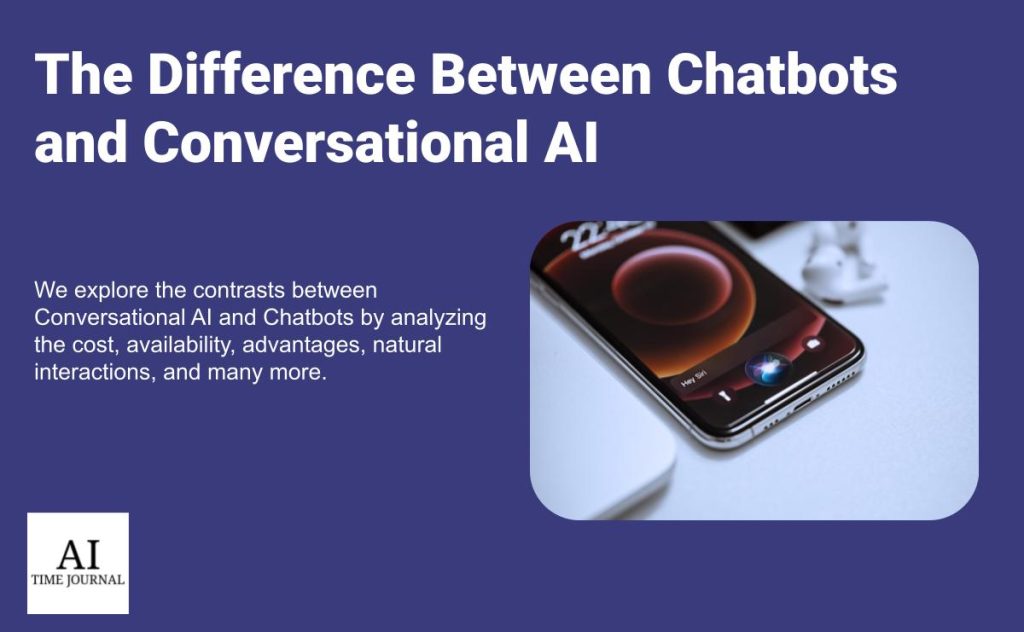
If you open up an e-commerce website and respond to the little welcome message that pops up in the corner, are you talking to a conversational AI or a chatbot? How about ChatGPT? It’s easy to think these are two examples of the same technology since you’re having a conversation with something that isn’t human. However, that’s not the case.
Chatbots and conversational AI (artificial intelligence) are different, though they are connected in certain ways. Read on to learn about the definition, differences, and advantages of chatbots and conversational AI.
Definition of Chatbots
Chatbots are used specifically in customer service and utilize either predefined conversation charts or artificial intelligence to create automated responses. There are multiple types of chatbots, some that users can only interact with using buttons, and others that can respond to text prompts.
Definition of Conversational AI
Conversational AI falls under a broader category of communication technology that can include AI-powered chatbots or virtual assistants. They use natural language processing (NLP) and machine learning to recognize our inputs and generate natural, contextually appropriate responses.
Differences between Chatbots and Conversational AI
Although the terms “chatbot” and “conversational AI” are often used to refer to the same software, they’re not the same thing.
Natural Language Processing (NLP)
NLP aims to give computers the ability to understand human language. For conversational AI, it’s an absolute necessity — without the ability to process the users’ messages, the AI can’t fulfill its purpose. Chatbots, however, can be made without any NLP abilities at all.
These are called rule-based chatbots, and they work according to a pre-written script and often have users click buttons with the questions they want to ask. Others can respond to written prompts, but instead of NLP, they use keywords and other identifiers to find a matching response.
Artificial Intelligence (AI)
Conversational AI is a type of artificial intelligence, and it relies on NLP, neural networks, and huge data sets to process our inputs and generate responses. They learn from the many texts and sources they’re given and use artificial intelligence and machine learning to mimic language patterns and produce relevant information.
Some higher-end chatbots also make use of artificial intelligence. This expands their abilities, allowing them to process customer inquiries and intelligently route tickets to the right departments and staff members. They’re typically trained on smaller sets of data because they only need to know information relevant to the client site.
Automation
Both chatbots and conversational AI are great tools for automation, but generally in different areas. Chatbots are designed for customer service purposes — they can automate simple tasks so human staff members have more time to deal with other matters.
Conversational AI, on the other hand, can be used in a much wider variety of areas. As well as powering chatbots and virtual assistants, conversational AI like OpenAI’s ChatGPT can also generate many kinds of text. They can write work emails, essays, articles, and short stories if you give them the right prompts. This can help automate the work and tasks of users in various industries, and students even use ChatGPT to study more effectively.
Advantages of Chatbots
It may sound like chatbots are a more limited version of conversational AI, but they have their strengths and advantages.
Cost
The first benefit of chatbots is the cost. Integrating a chatbot into your customer service system is not only affordable but also helps you save money by freeing up your staff. You can subscribe to a service that will provide and help you train chatbots for as little as $49 a month.
Availability
Chatbots have increased in popularity over the past few years, and there are now a lot of different options to choose from. Some popular companies offering chatbot services include Zendesk, WordPress, Hubspot, and Salesforce.
A lot of notable companies such as Dominoes, Amtrak, and Capital One also use them. The AI assistant Julie has saved travel company Amtrak $1 million in email customer service costs.
Advantages of Conversational AI
While chatbots have room to improve, it’s nothing compared to the potential of broader conversational AI. Shortly, many more applications of artificial intelligence will be developed.
Contextual Understanding
Understanding and remembering the context of a conversation is one of the most important and impressive aspects of conversational AI. You can refer back to earlier messages, and the AI will be able to keep up and draw on previous information to keep its responses relevant.
This helps users work on bigger projects with the AI, such as essays or coding projects, which require the user and AI to work together to edit and improve prior responses.
Natural Interactions
The ability of conversational AI to generate truly natural human language opens up a lot of new application possibilities. Some healthcare companies, such as Woebot, are already taking advantage of this.
Their mental health bot is designed to lend a supportive ear to anyone, anywhere, at any time. It can generate natural responses to anything users tell it, helping them feel heard and understood.
Conclusion
While some chatbots are a type of conversational AI, the two are not the same thing. A lot of chatbots don’t use artificial intelligence or NLP at all. Chatbots are designed for customer service, while conversational AI has a broader range of applications.
The advantages of chatbots in customer service are lower cost and time efficiency. You can decrease the number of tickets your staff has to deal with, while at the same time making some level of service available to customers 24/7. For conversational artificial intelligence and the future of humans, much is still to be discovered, but right now people are using them to write essays, act as virtual therapists, and even write code.
